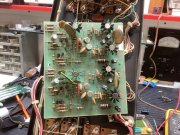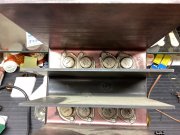I am new to this forum. I have a new-to-me PL400, first series, 8 fin, 14B driver board, SN 8396. It has PL909 OTs in one channel and NEC 2SD555 in another. Drivers on both channels are RCA 410. I have it all cleaned up and inspected. I found the OTs all test good as do the RCA 410s. I replaced all the electrolytic caps on the 14B board and I’ve order new Kemet 9100uf 100v filter caps and some new 200mv incandescent bulbs for the meters from mouser. I can’t find any bad transistors on the board although Q4 does look to be installed wrong. I’m guessing the drawing is wrong as well. It shows them facing one another.
I’d prefer to bring this up on a Variac protected by a 120w DBT so that I can monitor the emitter currents. I read on another form that the use of a variac was problematic but that statement was made without explanation as if it was a known issue. Can someone comment on that. I’d hate to blow up the OTs. I’m not convinced a DBT offers much protection for improperly biased OTs in such large numbers.
Here is some amp porn for you.


I’d prefer to bring this up on a Variac protected by a 120w DBT so that I can monitor the emitter currents. I read on another form that the use of a variac was problematic but that statement was made without explanation as if it was a known issue. Can someone comment on that. I’d hate to blow up the OTs. I’m not convinced a DBT offers much protection for improperly biased OTs in such large numbers.
Here is some amp porn for you.


Attachments
-
2.7 MB Views: 3

